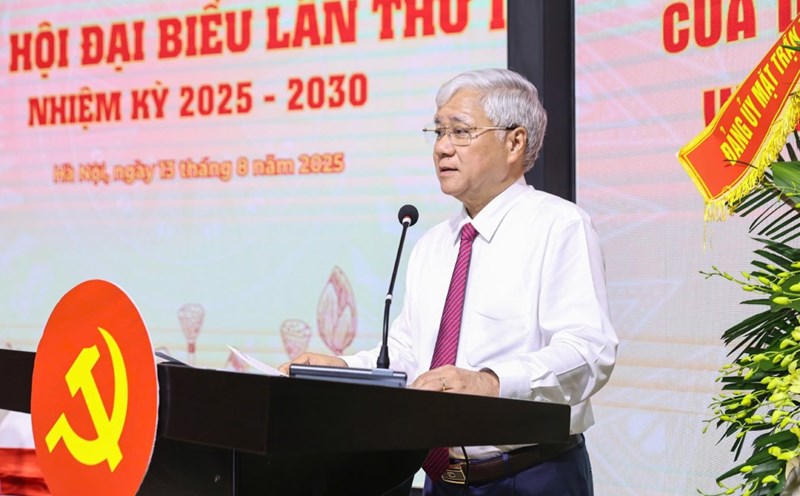Hanoi voters proposed to focus on developing the railway, air and road sectors to meet the requirements of the country's socio-economic development in the new period.
After studying, the Ministry of Construction responded as follows: Transportation is an important part of the socio-economic infrastructure.
This is one of three breakthroughs, it is necessary to prioritize investment in development one step ahead to create a premise for rapid and sustainable socio-economic development, ensuring national defense and security.
The Ministry of Construction agrees with the proposal of voters of Hanoi City that in the coming time, it is necessary to continue to promote the development of transport infrastructure in general and the railway, airline and road sectors in particular according to the plan to meet transportation needs, reduce logistics costs, open up new development space for the whole country, and achieve the double-digit continuous growth target for the period 2026-2030.
For the railway industry: This is a method of transport with advantages in terms of cost within medium to long distances; safe, convenient, and low environmental pollution; suitable for passenger and cargo transport corridors with large transportation needs and public passenger transport in urban areas.
Therefore, the goal by 2030: Focus on mobilizing resources to invest in the North-South high-speed railway; railway connecting seaports, airports, international border gates (Lao Cai - Hanoi - Hai Phong, Hai Phong - Ha Long - Mong Cai, Hanoi - Lang Son, Ho Chi Minh City - Can Tho, Thu Thiem - Long Thanh, Bien Hoa - Vung Tau, Vung Ang - Muoi Gia, ...); Coordinate with Hanoi City, Ho Chi Minh City to implement investment in urban railways according to the Resolution of the National Assembly.
Coordinate with localities to review planning and invest in urban railway lines to meet the needs of convenient, fast and safe travel after the arrangement of administrative units; connect provinces and cities with the North-South high-speed railway; connect localities with 02 growth poles: Hanoi City, Ho Chi Minh City to soon form a network of railway passenger and freight transportation nationwide according to the plan.
In addition, continue to upgrade and renovate to effectively exploit existing railway lines; gradually form and develop the railway industry; combine railway development with the development of urban areas and industries to contribute to restructuring the urban system nationwide.
For the aviation industry: This is a preferred mode of transportation for long distances, serving tourism development, high-value, short-term freight transport, combined with national defense, security and emergency relief.
Therefore, the goal by 2030: to focus on investment and put into operation Long Thanh International Airport Phase 1.
Research on upgrading and expanding Noi Bai and Tan Son Nhat International Airports; expand airports to meet transportation needs and develop the local economy and society (Cat Bi, Dong Hoi, Phu Cat, Phu Quoc, Ca Mau, etc.).
The Ministry of Construction said that by 2030, about 92-95% of the population will be able to access the airport within a 100km range.
Based on the orientation and needs for socio-economic development of the region, coordinate with localities to research and build specialized airports associated with large-scale production areas and tourism centers; take advantage of and restore existing and dual-use military airports. Effectively exploit and optimize the organization of airspace and flight methods of airports in operation and airports expected to be upgraded, expanded, and newly built during the planning period.
For the road industry: this is a suitable method of transportation, mainly for transporting goods and passengers at short distances, a flexible method that should be developed in economic corridors.
Therefore, the goal by 2030: Complete the construction of the North-South expressway in the East and expressways connecting to major economic centers, associated with dynamic regions such as Hanoi, Ho Chi Minh City, Da Nang, Can Tho, connecting special seaports, international airports, international border gates with large demand for import and export of goods; expressways associated with the formation of East-West economic corridors. Strive to put about 5,000km of expressway into operation nationwide by 2030.
Coordinate with localities to develop coastal road traffic corridors, as a basis for developing marine economic activities and developing coastal urban areas.
Strive to complete the investment in the coastal road by 2030, with a total length of about 2800 km (including sections overlapping with national highways).
Coordinate with localities to build a modern urban transport system, complete investment in belt routes in Hanoi and Ho Chi Minh City; traffic axes connecting Hanoi and Ho Chi Minh City with major cities in the region; connecting between major cities in the 01 province after the merger.
Thus, by 2030, a synchronous and modern national transport infrastructure framework will be basically formed, meeting the requirements of the country's socio-economic development in the new period as voters have expressed.
The Ministry also said that by 2030, it strives to be a developing country with modern industry, high average income, economic growth based on science, technology, innovation and digital transformation; a model of organizing an effective, unified, sustainable national development space, forming dynamic regions, economic corridors, and growth poles.











